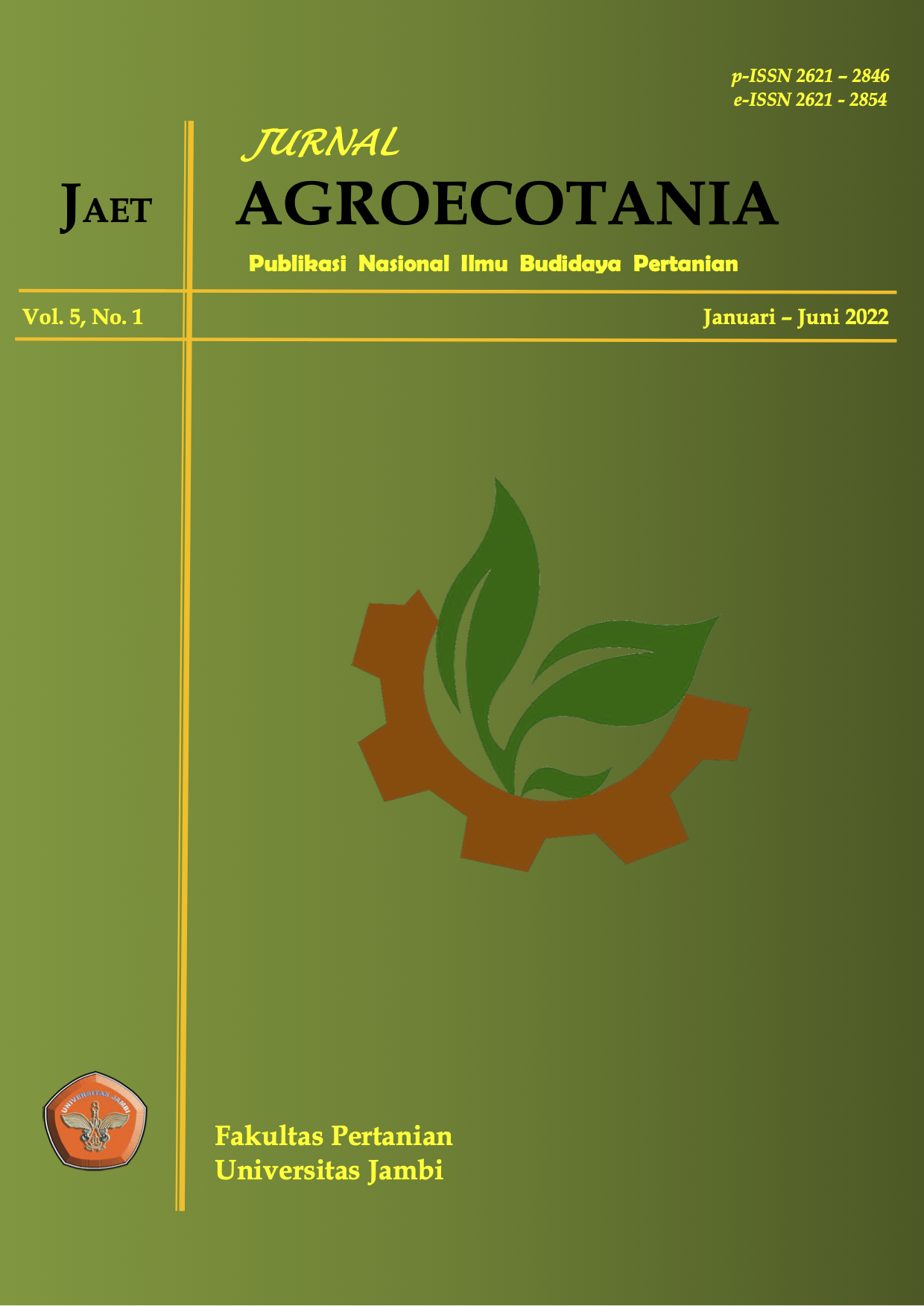Pemberian Biochar Sekam Padi Terhadap Pertumbuhan dan Hasil Padi (Oryza Sativa L.) Sawah Irigasi Teknis
DOI:
https://doi.org/10.22437/agroecotania.v5i1.22824Keywords:
Rice Husk Biochar, Rice Plant Growth, YieldAbstract
Rice plant (Oryza sativa L.) is the staple food crop of almost all Indonesians. In line with the increase in population from year to year, the need for rice also continues to increase. Therefore, efforts to increase production must continue. On the other hand, the decline in land area due to the conversion of functions from agricultural land to non-agricultural land also causes reduced production. However, in several regions the government has also printed new rice fields, which are generally not on fertile land. Therefore, efforts to increase production through improved farming or intensification, such as the application of new technological developments, need to be done. The aim of this study was to obtain the best dose in administering rice husk biochar for growth and yield of technically irrigated rice fields (Oryza sativa L.). The research was carried out in the Rice Fields of Rawa Medang Village, Batang Asam District, West Tanjung Jabung Regency, Jambi Province which lasted for 5 months, starting from December 26, 2019 to April 19, 2020. The experimental design used was a randomized block design (RAK). Provision of rice husk biochar at several dose levels, namely p0 = without rice husk biochar (300 kg Urea + 100 kg KCl + 100 kg SP-36), p1 = 5 tons ha-1 rice husk biochar + 1â„2 dose of urea + 1â„2 dose of KCl + 1â„2 dose SP-36, p2 = 10 tonnes ha-1 rice husk biochar + 1â„2 dose of urea +1â„2doseofKCl+1â„2doseofSP-36,p3 =15tonnesofha-1 biocharofricehusk+1â„2doseofurea+ 1â„2doseofKCl+1â„2doseofSP-36,p4 =20tonsha-1 ricehuskbiochar+1â„2doseofurea+1â„2doseof KCl+1â„2doseofSP-36,p5 =25tonsha-1 ofricehuskbiochar+1â„2doseofurea+1â„2doseofKCl+1â„2 dose of SP-36. The variables observed were plant height, maximum number of tillers, number of productive tillers, panicle length, number of grains per panicle, percentage of empty grain per panicle, dry grain yield and weight of 1000 grains of grain. The results showed that giving bochar of rice husk had an effect and could increase the growth and yield of rice plants. Provision of 5 tonnes of rice husk biochar ha-1 to 25 tonnes ha-1 increased the yield of the maximum number of tillers, the number of productive tillers, and the yield of milled dry unhulled rice. Provision of rice husk biochar 25 ton ha-1 gave the best effect on lowland rice plants.
Downloads

Downloads
Published
Issue
Section
License
Copyright (c) 2022 Wahyuni Lestari, Aryunis Aryunis, Akmal Akmal

This work is licensed under a Creative Commons Attribution-NonCommercial-ShareAlike 4.0 International License.
Please find the rights and licenses in Indonesian EFL Research & Practice.
- License
The non-commercial use of the article will be governed by the Creative Commons Attribution license as currently displayed on Creative Commons Attribution-NonCommercial-ShareAlike 4.0 International License.
- Author’s Warranties
The author warrants that the article is original, written by stated author(s), has not been published before, contains no unlawful statements, does not infringe the rights of others, is subject to copyright that is vested exclusively in the author and free of any third party rights, and that any necessary written permissions to quote from other sources have been obtained by the author(s).
- User Rights
Indonesian EFL Research & Practice's spirit is to disseminate articles published are as free as possible. Under the Creative Commons license, Indonesian EFL Research & Practice permits users to copy, distribute, display, and perform the work for non-commercial purposes only. Users will also need to attribute authors and Indonesian EFL Research & Practice on distributing works in the journal.
- Rights of Authors
Authors retain the following rights:
- Copyright, and other proprietary rights relating to the article, such as patent rights,
- The right to use the substance of the article in future own works, including lectures and books,
- The right to reproduce the article for own purposes, provided the copies are not offered for sale,
- The right to self-archive the article.
- Co-Authorship
If the article was jointly prepared by other authors, the signatory of this form warrants that he/she has been authorized by all co-authors to sign this agreement on their behalf, and agrees to inform his/her co-authors of the terms of this agreement.
- Termination
This agreement can be terminated by the author or Indonesian EFL Research & Practice upon two months’ notice where the other party has materially breached this agreement and failed to remedy such breach within a month of being given the terminating party’s notice requesting such breach to be remedied. No breach or violation of this agreement will cause this agreement or any license granted in it to terminate automatically or affect the definition of Indonesian EFL Research & Practice.
- Royalties
This agreement entitles the author to no royalties or other fees. To such extent as legally permissible, the author waives his or her right to collect royalties relative to the article in respect of any use of the article by Indonesian EFL Research & Practice or its sublicensee.
- Miscellaneous
Indonesian EFL Research & Practice will publish the article (or have it published) in the journal if the article’s editorial process is successfully completed and Indonesian EFL Research & Practice or its sublicensee has become obligated to have the article published. Indonesian EFL Research & Practice may conform the article to a style of punctuation, spelling, capitalization, referencing and usage that it deems appropriate. The author acknowledges that the article may be published so that it will be publicly accessible and such access will be free of charge for the readers.









